Over the years I have read an awful lot about water purification. Some of it was good advice. Some of it contained a few mistakes, exaggerations or inflated manufacturers claims. Some was flat out wrong.
A while ago I wrote an article that looked at the science of how fire works and how to apply it to an outdoors environment when you need a fire to keep you alive. This time I thought we might look at water and how to stop it making you ill or even killing you.
A lot of has been written about “purifying” water and how various methods of “purifying” are best. Before we even consider how to make water safe, perhaps we should consider what makes it unsafe.
Part 1 - The Contaminants
There are two main classifications of contaminants we need to concern ourselves with – organisms (living creatures) and chemicals (which may be organic or inorganic in nature but are not alive).
Organism Hazards
There are a large number of types of organisms that can exist in the water. The hazards in drinking water are small – very small. I’ll include rough size ranges when describing them. For consistency I’ll give all sizes in microns (a micron is one thousandth of a millimetre or one millionth of a metre. These include:
Viruses
A virus is a piece of nucleic acid wrapped in a coat of protein. It is not a cell and can only reproduce and grow by infecting a host where it inserts its nucleic acid into host cells.
Examples of water borne viruses include Hepatitis and Rotavirus
A virus is the smallest of the organic hazards we are discussing – they range in size from 0.3microns to 0.01microns.
Bacteria
Bacteria are single celled organisms with a complete set of nucleic acid (RNA and DNA) and are much larger than viruses (up to 100 times). Over 90% of bacteria are harmless or beneficial to humans but some are dangerous.
Examples of dangerous bacteria include Cholera and Typhoid
Bacteria measure 0.5microns to 5 microns
Protozoa.
Protozoa are single celled creatures. Larger and more complex than bacteria, they are commonly found in both water and soil. They are generally invisible to the naked eye – they range in size from ten microns to half a millimetre (or 500 microns) Some protozoa have the ability to form cysts.
Cysts
A cyst is a hard walled form of a micro-organism such as Giardia or Cryptospyridium, These cysts can survive in water or fecal matter for a long time and in conditions that the protozoa would not. Chlorine and Iodine for example may not reliably kill cryptospyridium cysts
Chemical Hazards
Many chemicals can be found in water – these include metals (lead, arsenic, mercury), nitrates / nitrites and many more. Their presence can be natural or the result of human activity. Mining can cause the presence of metals in the water supply (particularly in less regulated parts of the world), agricultural run off of fertilisers and pesticides are another common cause of chemical pollution.
Chemical contaminants have to be separated from the water to render it safe since they cannot be killed as organisms can.
Part 2 - The Treatments
Heat / Boiling
Heating water to a high enough temperature for a long enough time will kill all dangerous organisms. Advice from reputable sources varies but consensus seems to suggest that raising water to 100C will have killed all bacteria and viruses. Cysts are a little tougher and advice is to maintain 100 degrees C for one minute to be safe.
The amount of “boil time” advised by “authorities” varies. There are two reasons for this:
Altitude (and consequential air pressure) alters the boiling point of water. To take an extreme example, the pressure at the summit of Everest is about a third of sea level air pressure. At this altitude, water boils around 70C. Since 82C is the temperature at which bacteria are instantly killed, the problem is obvious. US EPA advice is that cysts which are probably the toughest of the organisms will be killed by ten minutes of exposure to water at 70C.
Turbidity. This is mucky murky water to you and me. Many micro organisms are found in soil. If soil particles are floating in water, they can insulate the organisms they contain from the rise in temperature for a period of time. The murkier the water, the longer the boil time should be sustained. Better yet is to use a coarse filter to remove larger soil particles.
Turbid Water
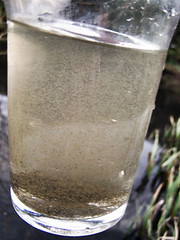
Conclusion
Clear water brought to a rolling boil at low altitude will be safe from organisms. The higher the altitude and the murkier the water, the longer a boil should be maintained (to a maximum of 15 minutes for dirty water whilst standing on the summit of Everest).
Filtration
There are really three subsets of filtration – I would term them “coarse”, “fine” and “ultra fine”.
Coarse filtration.
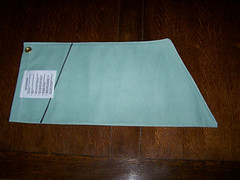
Coarse filtration will not remove either organic or chemical hazards since the barrier apertures are large enough to allow even protozoa to pass through. What coarse filtration will do however is screen out all but the finest of the particulates that cause turbidity. This will render boiling and chemical sterilisation far more effective and also hugely improve the palatability of water. The most common form of coarse filtration is the Milbank bag – a tightly woven canvas bag with a design optimised for coarse filtration.
Fine Filtration
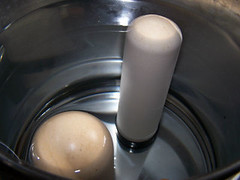
Fine filtration will certainly remove protozoa and cysts and the better quality filters will also remove bacteria. To look out a quality fine filter, look for “absolute” filtration of 1 micron or less. The most common form of fine filtration is a ceramic filter (often used in combination with other approached described later). A high quality ceramic filter will last indefinitely (although other combined products will not). It is important to note that fine filters, because they can trap bacteria, can become a breeding ground and source of contaminants. In order to alleviate this some form of secondary barrier is often included in the fine filter – often silver is used to prevent the bacteria surviving. A ceramic filter will also form a barrier to some metals and organic matter (but by no means all).
Ultra Fine Filtration
There are portable filters available that can filter out viruses. These are relatively new to the market and are still relatively expensive. I addition there is the process known as reverse osmosis. This is a very fine filter which water molecules are forced through with a pressure of 40 – 80 psi. Reverse osmosis can remove not only viruses but also salts (e.g. producing fresh water from salt water) and metal salts
Chemical
There are a variety of chemicals that will kill micro organisms – perhaps the most common are Iodine and Chlorine based products.
Chlorine
Chlorine based products attack the cell walls of organisms and then oxidise the intra cellular madder rendering harmless.
Bleach

The cheapest method of adding chlorine to water is to use plain, unscented household bleach (5% sodium hypochlorite). Add one drop (0.05ml) per litre – two if the water is cloudy and leave for at least 30 minutes. This works best in warmer water and may not be effective against protozoa and cysts. Household bleach is not the best solution for travelling as persistent shaking can result in loss of chlorine activity.
Chlorine tablets
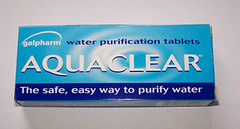
Tablets are far more convenient to carry, less subject to degradation by motion than household bleach they are a slightly different chemical (Sodium dichloroisocyanurate). The most common form uses 1 tablet per litre (although I would use two in cloudy (turbid) water). Water should be left for 10 minutes after the tablet has been added. Puritabs (the most common type) claim effectiveness against Giardia.
Note that acid pH water can reduce the efficacy of chlorine based products as an agent.
Iodine
Iodine is considered slightly more effective than chlorine based chemical approaches against protozoa and cysts, however even iodine based preparations did remove more than 90% of cysts in some tests unless left for 24 hours.
There are some health concerns over prolonged use of iodine (with the potential to lead to goitre). It is wise for young children, pregnant people and those with iodine allergy (or shellfish allergy which can be an indicator) to avoid the use of iodine-based preparations.
Some find the taste of iodine preparations unpleasant and use a “neutraliser” to remove the taste. It should be noted that adding the neutraliser renders the iodine ineffective so it should only be added after the correct waiting period (30 minutes to 1 hour if in doubt). It is worth mentioning that the “neutraliser” is soluble ascorbic acid (Vitamin C). Soluble vitamin C from the pharmacy will work just as well (and cost less). The risk of using a neutraliser is that any left in your water bottle will reduce the efficacy next time iodine is used.
Tincture of Iodine

Tincture of Iodine (Alcoholic Iodine Solution BP) - this is readily available from pharmacies and contains (generally) 2% iodine. Suggested doses vary, but to deactivate cycts, five drops per litre and a half to one hour wait period allowed at normal temperatures (more if cold)
Note that iodine should not be stored in plastic but in glass bottles with paper lined Bakelite caps. Iodine can leach in plastic bottles. This clearly carries some risk of breakage and iodine is messy stuff!
Iodine based tablets
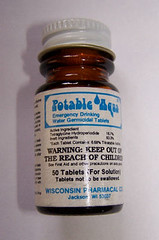
The most common type of these is “Potable Aqua” – they are tablet form Tetraglycine hydroperiodide. Each tablet contains 4mg of iodine. They are slow to dissolve and should be used up when the bottle has been opened.
Iodine crystals
It is possible to make your own iodine solution by the Kahn–Visscher method. This is done by putting 5g of iodine in a glass jar (about 30ml) with a paper lined Bakelite lid. The jar is filled with water. The saturated solution will disinfect about 2 litres of water but care must be taken not to draw up any crystals. A commercial version of this is Polar Pur.
Ultraviolet
Its worth noting that when harmful micro organisms are exposed to the ultraviolet light, their RNA /DNA is disrupted by absorbing the UV this makes the organism sterile and safe. UV is found commonly in “inline” systems for water drawn from wells and bore holes. It also has more “portable” variants – notably the “steri pen” battery powered UV water treatment system. Even leaving water in a clear bottle in strong sunlight will have a beneficial effect id done for a long enough period and in strong enough light. It should be noted though that any “cloudiness” in the water will render UV treatment ineffective so it is best combined with filtration.
Adsorption
One very useful item in water purification is activated charcoal. Activated charcoal is not the stuff from your barbecue (although its chemically similar). It is charcoal that has been altered by a special manufacturing techniques to make it highly porous. So porous in fact that a gram of activated charcoal has a surface area of up to 2,000 square metres. Activated carbon adsorbs (chemically bonds with) certain chemicals as they pass through it thereby trapping them and removing them from the water. This is not true of all chemicals – some are trapped:
Mercury, organic arsenic complexes, 245 T (dioxin) and chlorine. Its worth noting that chlorine is adsorbed – your carbon filter will remove the chemical taste from water but also prevent it being efficacious – always filter first and then chemically treat!
Its worth noting that activated charcoal can trap and become a breeding ground for bacteria. Some contain other materials (such as silver) to inhibit such bacterial growth however it is a good idea to regularly flush your carbon filter with clean decontaminated water to remove bacteria.
Activated charcoal is used in two forms – granular and block. Block both filters and adsorbs and is often seen as the superior product.
Resin Filters
Resin filters act on an ion exchange principle – they remove cations (e.g. lead and mercury) and anions (e.g. chlorides) with harmless ions such as hydroxyl (OH). Brita filters are a common example of ion exchange filters. Quality field use filters often combine activated charcoal with resin filters.
Distillation
Distillation is often thought to render all water safe. In effect water is heated to the point of evaporation and the steam gathered and condensed. The heating action will kill all micro organisms and many chemicals (with a higher boiling point than water) will be left behind and not come across in the distillate. It is a fuel heavy and mechanism to produce large quantities of fresh water although a variety of techniques (including the “solar still” and “connected bottles” will produce small quantities in extremis). It is worth noting that some chemicals (e.g. methanol) have a lower boiling point than water and can come across in distillation.
Part 3 - Practical Solutions
Having talked a lot of “theory” lets look at some practical solutions and discuss the pros and cons of each.
The “Low tech”
Perhaps the simplest of water filters is the “Milbank Bank” – a tightly woven canvas bag often issued to British Forces. Lets see how it works
This is a Milbank bag – it looks simple but its an elegant design. The hanging hole is opposite the “toe” of the sock shaped design causing it to hang “toe down” and allow the water filtering through it to be received accurately into a receiving vessel.

Although its normal to attach a simple cord to the bag, I use a carbiner so that I can tie the cord on, fill the bag from a stream and then quickly clip the bag in place (its heavy when full and you end up needing three hands to hang it. An alternative of course is to tie it up and then fill it using your billy etc.
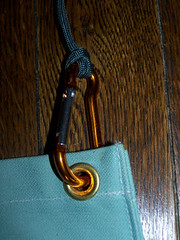
Before use its important to soak the bag to swell the fibres – dumping it in your billy can and squeezing it a few times after a good soak works well
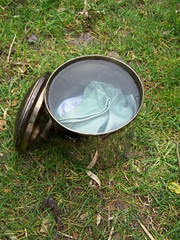
Fill the bag (I like to put it so the mouth faces up stream and let water do the work) and clip it in place
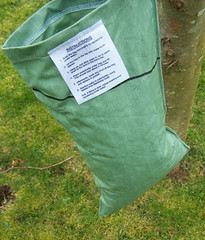
Let the water run out onto the ground until it finds the black line and then put the receiving vessel under it
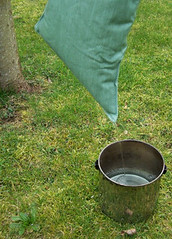
What we have at this point is coarse filtered water. We have not removed any organisms. Since we are going “low tech” here a good rolling boil (taking note of the warnings in the heat section) will do the trick. Please note that a rolling boil is big,fat bubbles – not a few little ones.
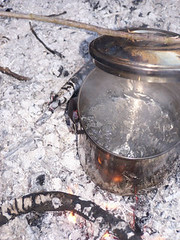
It would of course be fine to use chemical disinfection rather than boiling if this is your preference.
What are the advantages of the “Low tech” system? Well its simple, effective, does not wear out with use. The disadvantages? It takes a little longer than other systems and provides no protection against chemical hazards. Due to the relative coarse filtration, some degree or turbidity may remain leaving a slightly griity taste to the water.
“Medium Tech”

This filter (the Clearbrook Travel Filter) is a basic fine filter with activated charcoal.
Its use is simple – put water in the top and let gravity carry it through to a waiting water bottle. This will filter finer than the Milbank bag (although the water “load capacity is smaller requiring two or three “top ups” for a litre bottle).
The advantages of this method are finer filtration and some measure of chemical adsorbtion. Disadvantages are that water still requires disinfection chemically or by heat, the unit is both cumbersome and unstable (you need to hold it or put it somewhere really flat on a windless day)
High Tech

This is one of my favourite units. It has course and fine filters and iodine resin built in. It also nests neatly into the mouth of a 58 pattern water bottle. Water is pumped into a long tune (with course stuff filtered out through the pre filter)
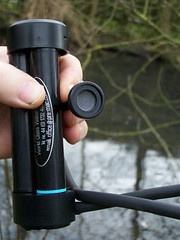
The water is fine filtered and iodine treated and available for drinking fairly quickly.
Advantages of this system are that it is “self contained” and does not require further chemical treatment. It is also very good at gathering water from puddles and standing ground water. Disadvantages is its relative expense, the fact that it takes about 5 minutes of pumping to produce a litre of water and the complexity – I carry spare “O” rings and filters just in case (although it is still a small unit even then). I do not believe the unit would be effective against all chemical contaminants but is safe for most “wild” water.
Portable
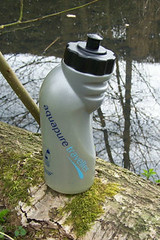
This is a neat device it combines iodine, fine filter and (I think) activated carbon. In use its as simple as fill, shake and wait (15 minutes) then the water is relatively safe.
The advantages of this system are its speed and relative simplicity. It can even be done whilst on the move – almost without stopping. The disadvantages are it cannot produce a large amount of water at one time, you MUST drink through the tube and it can be a bit of a faff adding water to cooking etc. Because its not pump based it is not that suitable for gathering water from puddles etc. Its hard to beat when travelling light or moving fast (or even when local water is suspect abroad).
Home based.
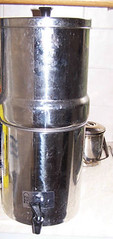
For home based use or even base camping, this unit is hard to beat. Made by Freshwater Filter (British Berkey make a similar unit) its gravity fed and contains some of the best filters made (ceramic, silver, activated charcoal and ion exchange resin). Up to 7 litres can be poured in the top where gravity forces it through two or four ceramic “candles” to the bottom where it is literally “on tap”

The advantages of this unit are its ease of operation, huge capacity and superior filters. Disadvantages are cost and the fact that it is not effective against viruses so boiling is still advised if viruses are suspected.
Conclusion
There are many more units around than those I have illustrated – these are intended only to be a representative sample – however knowing what approaches will combat the various types of contaminant will, I hope, help you make an informed choice when selecting your own water purification approach.
Red
A while ago I wrote an article that looked at the science of how fire works and how to apply it to an outdoors environment when you need a fire to keep you alive. This time I thought we might look at water and how to stop it making you ill or even killing you.
A lot of has been written about “purifying” water and how various methods of “purifying” are best. Before we even consider how to make water safe, perhaps we should consider what makes it unsafe.
Part 1 - The Contaminants
There are two main classifications of contaminants we need to concern ourselves with – organisms (living creatures) and chemicals (which may be organic or inorganic in nature but are not alive).
Organism Hazards
There are a large number of types of organisms that can exist in the water. The hazards in drinking water are small – very small. I’ll include rough size ranges when describing them. For consistency I’ll give all sizes in microns (a micron is one thousandth of a millimetre or one millionth of a metre. These include:
Viruses
A virus is a piece of nucleic acid wrapped in a coat of protein. It is not a cell and can only reproduce and grow by infecting a host where it inserts its nucleic acid into host cells.
Examples of water borne viruses include Hepatitis and Rotavirus
A virus is the smallest of the organic hazards we are discussing – they range in size from 0.3microns to 0.01microns.
Bacteria
Bacteria are single celled organisms with a complete set of nucleic acid (RNA and DNA) and are much larger than viruses (up to 100 times). Over 90% of bacteria are harmless or beneficial to humans but some are dangerous.
Examples of dangerous bacteria include Cholera and Typhoid
Bacteria measure 0.5microns to 5 microns
Protozoa.
Protozoa are single celled creatures. Larger and more complex than bacteria, they are commonly found in both water and soil. They are generally invisible to the naked eye – they range in size from ten microns to half a millimetre (or 500 microns) Some protozoa have the ability to form cysts.
Cysts
A cyst is a hard walled form of a micro-organism such as Giardia or Cryptospyridium, These cysts can survive in water or fecal matter for a long time and in conditions that the protozoa would not. Chlorine and Iodine for example may not reliably kill cryptospyridium cysts
Chemical Hazards
Many chemicals can be found in water – these include metals (lead, arsenic, mercury), nitrates / nitrites and many more. Their presence can be natural or the result of human activity. Mining can cause the presence of metals in the water supply (particularly in less regulated parts of the world), agricultural run off of fertilisers and pesticides are another common cause of chemical pollution.
Chemical contaminants have to be separated from the water to render it safe since they cannot be killed as organisms can.
Part 2 - The Treatments
Heat / Boiling
Heating water to a high enough temperature for a long enough time will kill all dangerous organisms. Advice from reputable sources varies but consensus seems to suggest that raising water to 100C will have killed all bacteria and viruses. Cysts are a little tougher and advice is to maintain 100 degrees C for one minute to be safe.
The amount of “boil time” advised by “authorities” varies. There are two reasons for this:
Altitude (and consequential air pressure) alters the boiling point of water. To take an extreme example, the pressure at the summit of Everest is about a third of sea level air pressure. At this altitude, water boils around 70C. Since 82C is the temperature at which bacteria are instantly killed, the problem is obvious. US EPA advice is that cysts which are probably the toughest of the organisms will be killed by ten minutes of exposure to water at 70C.
Turbidity. This is mucky murky water to you and me. Many micro organisms are found in soil. If soil particles are floating in water, they can insulate the organisms they contain from the rise in temperature for a period of time. The murkier the water, the longer the boil time should be sustained. Better yet is to use a coarse filter to remove larger soil particles.
Turbid Water

Conclusion
Clear water brought to a rolling boil at low altitude will be safe from organisms. The higher the altitude and the murkier the water, the longer a boil should be maintained (to a maximum of 15 minutes for dirty water whilst standing on the summit of Everest).
Filtration
There are really three subsets of filtration – I would term them “coarse”, “fine” and “ultra fine”.
Coarse filtration.

Coarse filtration will not remove either organic or chemical hazards since the barrier apertures are large enough to allow even protozoa to pass through. What coarse filtration will do however is screen out all but the finest of the particulates that cause turbidity. This will render boiling and chemical sterilisation far more effective and also hugely improve the palatability of water. The most common form of coarse filtration is the Milbank bag – a tightly woven canvas bag with a design optimised for coarse filtration.
Fine Filtration

Fine filtration will certainly remove protozoa and cysts and the better quality filters will also remove bacteria. To look out a quality fine filter, look for “absolute” filtration of 1 micron or less. The most common form of fine filtration is a ceramic filter (often used in combination with other approached described later). A high quality ceramic filter will last indefinitely (although other combined products will not). It is important to note that fine filters, because they can trap bacteria, can become a breeding ground and source of contaminants. In order to alleviate this some form of secondary barrier is often included in the fine filter – often silver is used to prevent the bacteria surviving. A ceramic filter will also form a barrier to some metals and organic matter (but by no means all).
Ultra Fine Filtration
There are portable filters available that can filter out viruses. These are relatively new to the market and are still relatively expensive. I addition there is the process known as reverse osmosis. This is a very fine filter which water molecules are forced through with a pressure of 40 – 80 psi. Reverse osmosis can remove not only viruses but also salts (e.g. producing fresh water from salt water) and metal salts
Chemical
There are a variety of chemicals that will kill micro organisms – perhaps the most common are Iodine and Chlorine based products.
Chlorine
Chlorine based products attack the cell walls of organisms and then oxidise the intra cellular madder rendering harmless.
Bleach

The cheapest method of adding chlorine to water is to use plain, unscented household bleach (5% sodium hypochlorite). Add one drop (0.05ml) per litre – two if the water is cloudy and leave for at least 30 minutes. This works best in warmer water and may not be effective against protozoa and cysts. Household bleach is not the best solution for travelling as persistent shaking can result in loss of chlorine activity.
Chlorine tablets

Tablets are far more convenient to carry, less subject to degradation by motion than household bleach they are a slightly different chemical (Sodium dichloroisocyanurate). The most common form uses 1 tablet per litre (although I would use two in cloudy (turbid) water). Water should be left for 10 minutes after the tablet has been added. Puritabs (the most common type) claim effectiveness against Giardia.
Note that acid pH water can reduce the efficacy of chlorine based products as an agent.
Iodine
Iodine is considered slightly more effective than chlorine based chemical approaches against protozoa and cysts, however even iodine based preparations did remove more than 90% of cysts in some tests unless left for 24 hours.
There are some health concerns over prolonged use of iodine (with the potential to lead to goitre). It is wise for young children, pregnant people and those with iodine allergy (or shellfish allergy which can be an indicator) to avoid the use of iodine-based preparations.
Some find the taste of iodine preparations unpleasant and use a “neutraliser” to remove the taste. It should be noted that adding the neutraliser renders the iodine ineffective so it should only be added after the correct waiting period (30 minutes to 1 hour if in doubt). It is worth mentioning that the “neutraliser” is soluble ascorbic acid (Vitamin C). Soluble vitamin C from the pharmacy will work just as well (and cost less). The risk of using a neutraliser is that any left in your water bottle will reduce the efficacy next time iodine is used.
Tincture of Iodine

Tincture of Iodine (Alcoholic Iodine Solution BP) - this is readily available from pharmacies and contains (generally) 2% iodine. Suggested doses vary, but to deactivate cycts, five drops per litre and a half to one hour wait period allowed at normal temperatures (more if cold)
Note that iodine should not be stored in plastic but in glass bottles with paper lined Bakelite caps. Iodine can leach in plastic bottles. This clearly carries some risk of breakage and iodine is messy stuff!
Iodine based tablets

The most common type of these is “Potable Aqua” – they are tablet form Tetraglycine hydroperiodide. Each tablet contains 4mg of iodine. They are slow to dissolve and should be used up when the bottle has been opened.
Iodine crystals
It is possible to make your own iodine solution by the Kahn–Visscher method. This is done by putting 5g of iodine in a glass jar (about 30ml) with a paper lined Bakelite lid. The jar is filled with water. The saturated solution will disinfect about 2 litres of water but care must be taken not to draw up any crystals. A commercial version of this is Polar Pur.
Ultraviolet
Its worth noting that when harmful micro organisms are exposed to the ultraviolet light, their RNA /DNA is disrupted by absorbing the UV this makes the organism sterile and safe. UV is found commonly in “inline” systems for water drawn from wells and bore holes. It also has more “portable” variants – notably the “steri pen” battery powered UV water treatment system. Even leaving water in a clear bottle in strong sunlight will have a beneficial effect id done for a long enough period and in strong enough light. It should be noted though that any “cloudiness” in the water will render UV treatment ineffective so it is best combined with filtration.
Adsorption
One very useful item in water purification is activated charcoal. Activated charcoal is not the stuff from your barbecue (although its chemically similar). It is charcoal that has been altered by a special manufacturing techniques to make it highly porous. So porous in fact that a gram of activated charcoal has a surface area of up to 2,000 square metres. Activated carbon adsorbs (chemically bonds with) certain chemicals as they pass through it thereby trapping them and removing them from the water. This is not true of all chemicals – some are trapped:
Mercury, organic arsenic complexes, 245 T (dioxin) and chlorine. Its worth noting that chlorine is adsorbed – your carbon filter will remove the chemical taste from water but also prevent it being efficacious – always filter first and then chemically treat!
Its worth noting that activated charcoal can trap and become a breeding ground for bacteria. Some contain other materials (such as silver) to inhibit such bacterial growth however it is a good idea to regularly flush your carbon filter with clean decontaminated water to remove bacteria.
Activated charcoal is used in two forms – granular and block. Block both filters and adsorbs and is often seen as the superior product.
Resin Filters
Resin filters act on an ion exchange principle – they remove cations (e.g. lead and mercury) and anions (e.g. chlorides) with harmless ions such as hydroxyl (OH). Brita filters are a common example of ion exchange filters. Quality field use filters often combine activated charcoal with resin filters.
Distillation
Distillation is often thought to render all water safe. In effect water is heated to the point of evaporation and the steam gathered and condensed. The heating action will kill all micro organisms and many chemicals (with a higher boiling point than water) will be left behind and not come across in the distillate. It is a fuel heavy and mechanism to produce large quantities of fresh water although a variety of techniques (including the “solar still” and “connected bottles” will produce small quantities in extremis). It is worth noting that some chemicals (e.g. methanol) have a lower boiling point than water and can come across in distillation.
Part 3 - Practical Solutions
Having talked a lot of “theory” lets look at some practical solutions and discuss the pros and cons of each.
The “Low tech”
Perhaps the simplest of water filters is the “Milbank Bank” – a tightly woven canvas bag often issued to British Forces. Lets see how it works
This is a Milbank bag – it looks simple but its an elegant design. The hanging hole is opposite the “toe” of the sock shaped design causing it to hang “toe down” and allow the water filtering through it to be received accurately into a receiving vessel.

Although its normal to attach a simple cord to the bag, I use a carbiner so that I can tie the cord on, fill the bag from a stream and then quickly clip the bag in place (its heavy when full and you end up needing three hands to hang it. An alternative of course is to tie it up and then fill it using your billy etc.

Before use its important to soak the bag to swell the fibres – dumping it in your billy can and squeezing it a few times after a good soak works well

Fill the bag (I like to put it so the mouth faces up stream and let water do the work) and clip it in place

Let the water run out onto the ground until it finds the black line and then put the receiving vessel under it

What we have at this point is coarse filtered water. We have not removed any organisms. Since we are going “low tech” here a good rolling boil (taking note of the warnings in the heat section) will do the trick. Please note that a rolling boil is big,fat bubbles – not a few little ones.

It would of course be fine to use chemical disinfection rather than boiling if this is your preference.
What are the advantages of the “Low tech” system? Well its simple, effective, does not wear out with use. The disadvantages? It takes a little longer than other systems and provides no protection against chemical hazards. Due to the relative coarse filtration, some degree or turbidity may remain leaving a slightly griity taste to the water.
“Medium Tech”

This filter (the Clearbrook Travel Filter) is a basic fine filter with activated charcoal.
Its use is simple – put water in the top and let gravity carry it through to a waiting water bottle. This will filter finer than the Milbank bag (although the water “load capacity is smaller requiring two or three “top ups” for a litre bottle).
The advantages of this method are finer filtration and some measure of chemical adsorbtion. Disadvantages are that water still requires disinfection chemically or by heat, the unit is both cumbersome and unstable (you need to hold it or put it somewhere really flat on a windless day)
High Tech

This is one of my favourite units. It has course and fine filters and iodine resin built in. It also nests neatly into the mouth of a 58 pattern water bottle. Water is pumped into a long tune (with course stuff filtered out through the pre filter)

The water is fine filtered and iodine treated and available for drinking fairly quickly.
Advantages of this system are that it is “self contained” and does not require further chemical treatment. It is also very good at gathering water from puddles and standing ground water. Disadvantages is its relative expense, the fact that it takes about 5 minutes of pumping to produce a litre of water and the complexity – I carry spare “O” rings and filters just in case (although it is still a small unit even then). I do not believe the unit would be effective against all chemical contaminants but is safe for most “wild” water.
Portable

This is a neat device it combines iodine, fine filter and (I think) activated carbon. In use its as simple as fill, shake and wait (15 minutes) then the water is relatively safe.
The advantages of this system are its speed and relative simplicity. It can even be done whilst on the move – almost without stopping. The disadvantages are it cannot produce a large amount of water at one time, you MUST drink through the tube and it can be a bit of a faff adding water to cooking etc. Because its not pump based it is not that suitable for gathering water from puddles etc. Its hard to beat when travelling light or moving fast (or even when local water is suspect abroad).
Home based.

For home based use or even base camping, this unit is hard to beat. Made by Freshwater Filter (British Berkey make a similar unit) its gravity fed and contains some of the best filters made (ceramic, silver, activated charcoal and ion exchange resin). Up to 7 litres can be poured in the top where gravity forces it through two or four ceramic “candles” to the bottom where it is literally “on tap”

The advantages of this unit are its ease of operation, huge capacity and superior filters. Disadvantages are cost and the fact that it is not effective against viruses so boiling is still advised if viruses are suspected.
Conclusion
There are many more units around than those I have illustrated – these are intended only to be a representative sample – however knowing what approaches will combat the various types of contaminant will, I hope, help you make an informed choice when selecting your own water purification approach.
Red
Last edited:
